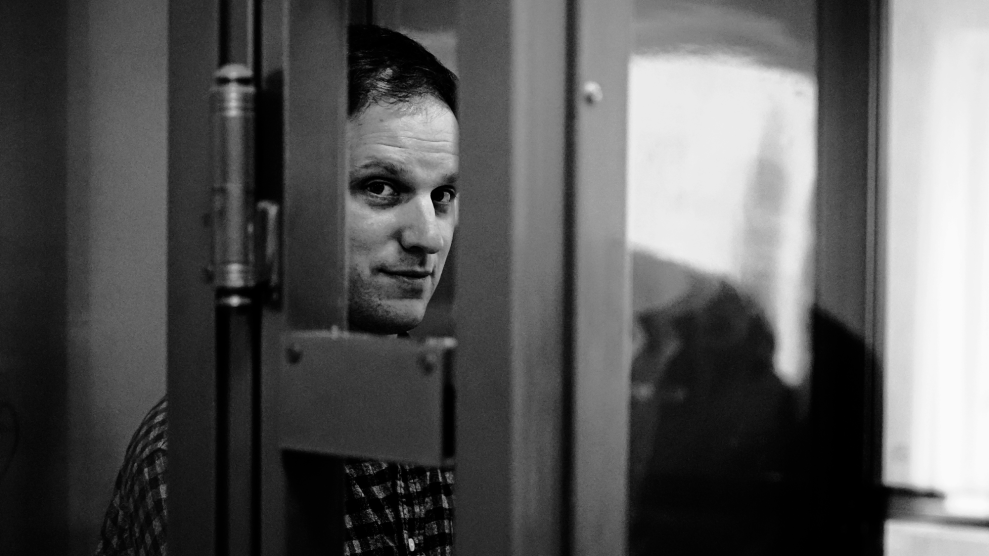News on the March
In purely dramatic terms, the process of making (and breaking) the news makes for some riveting stories. Classic films from Citizen Kane to Network have explored the moral dimensions of the newsroom, but we recommend these less obvious choices. —John Aboud
His Girl Friday Howard Hawks. 92 minutes. VCI Home Video, 1940. In this classic comedy, Cary Grant and Rosalind Russell tear through their dialogue, but their characters tear through journalistic ethics. The pair, a newspaper editor and his reporter ex-wife, is hell-bent on saving a death row convict, primarily for the newsstand potential. Based on Ben Hecht and Charles MacArthur’s The Front Page, it is faithful to the play’s glib yet pointed demeanor. Political corruption and racial politics (the convict’s victim was a black cop) only fuel the comic tension.
Sweet Smell of Success Alexander Mackendrick. 96 minutes. MGM/UA Home Video, 1957. Clifford Odets and Ernest Lehman’s screenplay makes for one of Hollywood’s most brutal film noirs, even though there’s not a detective in sight. J.J. Hunsecker, a Walter Winchell-like gossip columnist, manipulates an obsequious press agent played by Tony Curtis—until their schemes collide, with disastrous consequences. Hunsecker’s conflation of his popularity with American virtue reveals the degradation of journalism in a society obsessed with drugs, communism, and scandal. Burt Lancaster’s performance as Hunsecker ranks among the scariest portrayals of Cold War-era villainy.
Between the Lines Joan Micklin Silver. 101 minutes. Vestron Video, 1977. Jeff Goldblum first deployed his archetypal wise-guy character here, as a rock critic at a sagging Boston alternative weekly. Though the script is about as taut as an NBC workplace sitcom, Goldblum, John Heard, and Bruno Kirby endearingly enact a passion play of idealistic journalists staring down the big sellout—should they stay independent and starve or take money from The Man?—a dilemma even more relevant now that alternapapers are a big business.
The Year of Living Dangerously Peter Weir. 114 minutes. MGM/UA Home Video, 1983. Given the recent turmoil in Indonesia, this political romance starring Mel Gibson and Sigourney Weaver has a new urgency. Gibson plays an Australian Broadcasting Service correspondent who arrives in Jakarta on the brink of a Communist uprising in the mid-1960s. Once he realizes he has uncovered the scoop of his dreams, he must make a painful evaluation of his loyalties.
Natural Born Killers Oliver Stone. 118 minutes. Warner Home Video, 1994. Oliver Stone and Quentin Tarantino, who wrote the story, create a cartoon indictment of increasingly cartoonish trends in shock journalism. Two mass murderers leave a trail of bodies through the Southwest, with tabloid TV show “American Maniacs” in hot pursuit. The argument that something this appallingly graphic could be a high-minded satire is juvenile, but then mass consumption of mass murder isn’t a subject that lends itself to good taste.
books
 |
| New York Diaries |
The New York Diaries: Too-True Tales of Urban Trauma By Daniel Drennan. New York: Ballantine Books, 1998. 256 pages. $11.95. Editor of the zine Inquisitor, Daniel Drennan is best known for his detailed online summaries of “Beverly Hills, 90210.” In his first book, he recounts hilarious yet disturbing episodes of his life in New York City, where his dog gets invited to parties (but he doesn’t) and customers at the bookstore where he works browse for volumes to match their interior decor. With rhapsodic sentences that can run for an entire paragraph, Drennan captures the spirit of a city whose frenetic pace almost precludes stopping to reflect—even for a period. —K.I.
Smoke and Mirrors: Short Fictions and Illusions By Neil Gaiman. New York: Avon Books, 1998. 352 pages. $24. Briton Neil Gaiman is a serious writer with a serious handicap: His background is in comic books, and his bailiwick is the fantastic. His Sandman comic series, though held in high cult regard, probably won’t win the literary acclaim of the graphic novel Maus. Short fiction like Gaiman’s, in the tradition of Harlan Ellison and Ray Bradbury, rarely gets the respect it deserves. But Gaiman knows what all the best fantasists know: The impossible is sometimes the best way to illuminate certain out-of-the-way crannies in the human soul, as he does here to heartbreaking effect. —B.D.
Birds of America By Lorrie Moore. New York: Alfred A. Knopf, 1998. 304 pages. $23. The characters in Lorrie Moore’s first short-story collection since Like Life, which appeared in 1990, hardly know how to fly. Rather than propelling themselves forward, they run in repeated patterns of disillusionment, mired in the pathetic circumstances of their lives. Their broken dreams are enlivened by Moore’s charm and humor, but her characters lack something nonetheless—as if lives are not stories, but, as Moore herself writes in the book, “a collection of accidents.” —J.D.
Mr. Mike: The Life and Work of Michael O’Donoghue By Dennis Perrin. New York: Avon Books, 1998. 432 pages. $25. Dennis Perrin confesses in his introduction that he considers the late Michael O’Donoghue “a personal god,” and he proves himself a loyal apostle throughout the rest of his book. O’Donoghue, the caustic humorist who emulated the stylings of de Sade more than, say, Thurber, certainly deserves Perrin’s meticulous appraisal. O’Donoghue’s work in the early years of both National Lampoon and “Saturday Night Live” brought graphic violence, self-conscious racism, and transgressive sexuality closer to the mainstream of American pop culture. While expertly exposing his subject’s self-manufactured persona, Perrin does little to question it. O’Donoghue’s epic fits of selfishness and spoiled pique, which wash across page after page, are attributed only to eccentricity and a cherished philosophy of comedy. There would be no harm in laying bare his pretension—of speaking a little ill of the dead. Skewering the dying and deceased was O’Donoghue’s specialty. —J.A.
 |
| Calamaties of Exile |
Calamities of Exile: Three Nonfiction Novellas By Lawrence Weschler. Chicago: University of Chicago Press, 1998. 199 pages. $25. As the lives of the three men (an Iraqi, a Czech, and a South African) profiled in this collection show, exile is a prolonged state of paradox. Exiled because they protested what became of their homes, their identities are centered on loss; their sense of who they are is based on where they cannot be. It’s this mythic irony, combined with Lawrence Weschler’s extraordinary eye for humor and beauty in even the direst circumstances, that push his work beyond reporting into literature. The book’s final profile—of South African author and artist Breyten Breytenbach—sketches most clearly the shifting terrain of nationality, family, loyalty, and justice that is the background for all these tales. While Breytenbach’s writing stands well on its own, Weschler does a good job of broadening its context. Through his portraits of these three men, he reveals the meaning of exile, a definition inextricable from the meaning of home. —A.M.C.
music
 |
| Cat Power |
Moon Pix Cat Power. Matador, 1998. The combination of Chan Marshall’s clear, strong voice and the plaintive, silvery guitar of Mick Turner (of the instrumentalist postpunk band the Dirty Three) makes Moon Pix Cat Power’s most provocative presentation yet. Songs such as “American Flag” and “Moonshiner” are both otherworldly and immediate at the same time, Southern gothic rock music for humid evenings and dysfunctional family gatherings. Less elaborate productions, such as the simple fable “Colors and the Kids” or the merely gorgeous “Cross Bones Style,” worm their way into a listener’s subconscious like ghost stories: Marshall’s keening floats into your dreams, the soundtrack to Faulkner works you forgot you read. —A.M.C.
XO Elliott Smith. Dreamworks, 1998. With his three independently released albums over the last four years, Elliott Smith won a following as devoted and passionate as his work. Smart and sensitive, he rummaged through the dime-store banality of loss only to emerge with perfect, piercing slivers of songs. On XO, his major label debut, Smith’s songs are less spare but no less moving. Vaguely Beatles-esque in their orchestration, XO‘s melodies are a restrained counterpoint to lyrics that are emotional but never cloying. To be sure, lovesick troubadours can be formulaic, but Smith’s improbable (and unfashionable) earnestness manages to transcend even the album’s two waltzes, suggesting that heartbreak is at least as powerful as cliché. —A.M.C.
 |
| Squirrel Nut Zippers |
Perennial Favorites Squirrel Nut Zippers. Mammoth Records, 1998. The Squirrel Nut Zippers have managed to pull off a delicate balancing act: They play aggressively old-fashioned music that’s still more fresh and novel than most of what’s considered “cutting edge” in the antiseptic world of contemporary popular music. The songs on Perennial Favorites—all original compositions—range from rollicking swing to saucy calypso to exuberant Dixieland to languid torch songs, and none of them would have sounded at all out of place at the Cotton Club or on the radio between the wars. At a time when pop music is swamped with artists camouflaging their derivative music with affected devotion to bygone idols, the Squirrel Nut Zippers’ genuine love letter to the sounds of long ago is a welcome relief. —J.C.
China: Time to Listen Various Artists. Ellipsis Arts, 1998. New Age interpretations of Chinese folk music are best buried beneath the Great Wall—all except this exhaustive overview of traditional and neoclassic forms. Composed of at most a few dozen modulations, this ancient music has changed little through the centuries. Producer Josef Bomback hasn’t narrowed the selection for more restless contemporary tastes, but instead gives the music a generous forum, so its repetitive rhythms can create their own spell. The repertoire is represented best and most by the high-pitched suona (a double-reed wind instrument), gritty erhu (a two-string fiddle), and clanging dragon gongs—with glossary and bibliography, to boot. —I.C.
movies
Sonatine Takeshi Kitano. 94 minutes. Miramax Home Entertainment, 1998. This is a Japanese gangster film about waiting, not shooting. With only brief, dispassionate violence, it lingers in the offices and rented bungalows where hit men—some young and eager, others old and numb—wait for the coast to clear. The movie’s writer, director, and star, Takeshi Kitano, better known as “Beat” Takeshi, is a well-loved stand-up comedian (as well as essayist, writer, poet, and any number of other things), and the humor here comes by richly portraying the sad, empty yakuza world and charting its subtle shifts. The movie is long and slow, sure to send John Woo fans fleeing and to occasionally bore everyone else—but it is a fine, stark image of tough men who finally have the time to look inside themselves. —A.J.D.
Don’t Look Back DA Pennebaker. 96 minutes. Artistic License Films, 1998. It’s a sloppy, scattered, fascinating ride through London with Bob Dylan during a 1965 concert tour. The film, first shown in 1967 and rereleased this year, brings us into Dylan’s hotel and backstage rooms, onto his concert stages, and into claustrophobic cars surrounded by screaming teens. The painful, awkward scenes of British journalists and fans trying to decipher this young man—and Dylan trying hard to be impenetrable—are nasty, but you can’t stop staring. There are beautiful moments, too, of Dylan, Joan Baez, and friends playing guitars and singing happily when no eager eyes intrude. For Dylan fans, the movie is essential; for others, it’s a rare behind-the-scenes look at a self-conscious revolution in the making. —A.J.D.
Reviews by John Aboud, Ian Christe, John Cook, Ana Marie Cox, Adam J. Davidson, Joanna Dionis, Brian Doherty, and Katie Isenberg.















